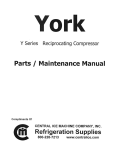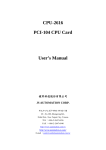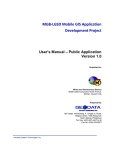Download Operating Instructions 5-Phase Stepping Motor Drive smd553
Transcript
Operating Instructions 5-Phase Stepping Motor Drive smd553 Revision: 44/99 BAUR Drives and Controls 1 Documentation: smd553 Product Features - For all common 5-Phase stepping motors - Powerful power drive: bipolar, chopped, low noise and little losses - Very compact size: L:W:H (125:100:35) mm - Only one operating voltage of 21 Volt to 40 Volt required - Motor current setting with scaled potentiometer (1,0 to 2,5) A - 4000, 2000, 1000, and 500 steps/revolution - Automatic current reduction can be enabled - Active ballast circuit against over voltage - Integrated fan control at over temperature - All connection with robust screw terminal technology - Inputs: Pulse, Direction, Fast Run, Gate/Off, Reset, Location of the control elements BAUR Drives and Controls 2 - Outputs: Zero position (Index), Ready, Fan control - All signals are galvanically isolated with opto couplers - Step frequency up to 100 kHz - LED-display for Power, Ready, Zero position, Over-temperature, Ballast circuit, Current reduction - Protection against Over-temperature, Over-current and Voltage surge (integrated active ballast circuit) Options: - 5V or 24V signal interface - Function Gate(Gate) or Off(Power drive off) selectable via jumpers - Fan module for operation with high motor current Documentation: smd553 Wring Diagram Function Description FR: GDR: (GATE, POWER DRIVE_OFF, RESET) The function of the input GDR depends on the jumper setting „OFF“ or „GATE“. A lower step resolution is selected if the input is activated. The effect is that the right jumper setting becomes active: The has the following effect on the step rate: - 4000 -> 1000 - 2000 -> 500 - 1000/500 -> no effect Function GATE: (Jumper set to „GATE“) All pulses are ignored by the power drive is the input GDR is active. With this function it is possible to operate multiple power drive with one pulse source. Function POWER DRIVE_OFF: (Jumper set to „OFF“) The active signal switches off the motor current, so that the motor shaft can be easily manually moved. However, the internal step counter is not deleted with this function. Function RESET: (Always active) Switches from the error condition to the operating condition BAUR Drives and Controls 3 (Fast Run) !Attention: Switching is only possible without offset in the so-called zero position. This zero position is automatically set at power drive on and is indicated via LED and output. PULSE: With a positive signal a step is moved. The power drive reacts only on signal edges. With active current reduction (Jumper „current reduction“ inserted) and pulse interruptions for more than approx. 100ms, the motor current is reduced to approx. 60% of the set value. Documentation: smd553 The current reduction does not work if the pulse signal remains static active. DIR: (DIRECTION) The direction signal sets the motor sense of rotation. READY: (Readiness) This output is active when power drive operates error free. The following errors switch the output to high impedance: Over-voltage, Over-temperature ZERO: (Zero position) The output „ZERO“ or zero position can be used for an exact reference point. This output becomes active in the so-called zero position, which is set at power-on and which is always a half step position. The output is switched active as follows: 4000/80, 2000/40, 1000/20 500/10, on condition that the movement is always in the same direction. The zero position is indicated with the LED „ZERO“. FAN: The output „FAN“ becomes active at a heat sink temperature over approx. 60 Grad. This is to be interpreted as an over-temperature warning. With this output the fan module (available as an option) can be controlled automatically. The condition is indicated with an LED. If the heat sink temperature exceeds 70 degrees Celsius, the power drive is disabled. UB,GND: (Power Supply) The power drive can be operated within a range of 21 to max. 40 Volt. It must be guaranteed that the power supply output voltage does not exceed 40 Volt at no-load operation and +10% mains voltage and that there is a sufficient charge capacitor connected of at least 6800yF. An active ballast circuit prevents over-voltages caused by generator operation at rapid decelerations. This condition is indicated with an LED that must only shortly be lit. Motor cable connection Under no circumstances the motor cable must be disconnected during operation. Induction voltages can destroy the power drive. For this reason it is important to have a good connection between the motor cable wires and the screw terminals. Motors current setting: (approximate values) The motor current can very easily be set with the potentiometer. Generally it can be said that only as much current is set as necessary. The following table of settings can be helpful. Fully CCW 9 O’clock 12 O’clock 3 O’clock Fully CW 1,0 A 1,2 A 1,5 A 2,0 A 2,5 A Motor current setting T[°C] 12 70 60 9 Fan Drive disabled BAUR Drives and Controls 4 3 Documentation: smd553 The set motor current will be reduced at higher step frequencies because of the motor inductance. The result is a reduction of the motor torque (see motor specifications of the motor manufacturer). A high current motor version with low impedance is recommend. Automatic current reduction The automatic current reduction is activate by setting the jumper „CURRENT REDUCTION“. The motor current is reduced to approx. 60% of the set motor current. The power dissipation of the motor and the power supply is reduced significantly. The current reduction is activated if the pulse input is inactive for more than 100ms. Current reduction Pulse Reduction At pulse frequencies of less than 10 Hz it is possible that the current reduction is very shortly activated. To avoid this, the start/stop-frequency should be step much higher than this 10 Hz. The current reduction can be blocked if the pulse input remains at static high signal level. Immediately after an active pulse input the nominal current is set again BAUR Drives and Controls 5 Error mode The readiness signal will be switched off. The motor is switched off. The ready LED is switched off. The error condition is memorized and can only be reset by activating the inputs „GDR“. The error mode is initiated if the temperature exceeds approx. 70°C Documentation: smd553 Signal Timing PULSE DIR GDIS tprvt tprvt: tpvr: tpnr: tprnt: tpab: tpvr tpnr PULSE/DIR before active GDIS PULSE before DIR PULS after DIR PULS/DIR after GDIS Current reduction after PULSE tprnt min. 5ys min. 10ys min. 10ys min. 50ms max. 100ms PULSE Reduction tpab: Board Dimensions 125 32 117 91,5 100 alle holes 3,5mm BAUR Drives and Controls 6 Documentation: smd553 Technical Data: Trouble Shooting: Module supply: Absolute max. supply voltage: Min. supply voltage Recommended supply voltage: Active ballast circuit: Supply voltage ripple: Input current at 35V/Im =max Starting current: Fuse: Charge capacitor: Supply cable wire cross section: Distance to the charge capacitor: 42 V max. 21 V 38 V > 46V 2 Vss max. 1,5 A max. <3,0 A 4,0 A mt 10000 yF 0,75 mm² 1,0m max. Motor connection: Cable cross section: Cable length: 0,75 mm² 10 m max Motor has no holding torque moment, although voltage is connected Motor voltage is below the min. value Power drive is switched off via the input „GDR/OFF“ Over-temperature shut off is still active Motor generated holding torque but does not execute steps Input „GDR/GATE“ is active Pulse level is too low (24V interface) „TEMP“-LED is lit immediately after power-on The heat sink was not able to cool down sufficiently Sudden crackling noises in the motor The motor is operated at the low voltage limit Bad contact of the motor connection Signal input interface: 5V (24V optional) Input type: Opto coupler, reverse polarity proof Input voltage: min. 4 V (21V) max. 6 V (28V) nominal 5 V (24V) Input current 15 mA (10mA) Pulse width: min. 5ys Pulse rise time: max. 10ys The motor starts but does not reach the end velocity The motor voltage is too low for the required speed Motor current set too low Acceleration ramp set too high Motor wires too long and/or too thin Power drive is under dimensioned and voltage drop is too high Motor looses steps and drifts Control signal amplitudes are too low Control signal rise times are too high Noise on signal wire is too high (Shielding ?) Wiring concept is not optimal (all ground signals must be wired in a star configuration to a common ground potential) Mechanical shaft coupling slips Signal output interface: Output type: Opto coupler, reverse polarity proof Switching voltage: min. 3V max. 30 V Switching current: max. 50 mA Output resistance: 220 Ohm Load: only ohmic Motor current setting: Potentiometer CCW position: 1,0 A CW position: 2,5 A linear in between ! Forced air cooling is necessary for motor currents higher than 1,5 A Temperature monitoring: Warning, Output „Fan on“: Shut off: The motor vibrates at pulse frequency but does not start Start/Stop-Frequency too high Motor windings wrongly connected or broken cable Automatic current reduction remains active (to little pulse duration at low pulse frequencies) Motor current set too low 60 ° Automatic current reduction does not work Pulse input remains active after the last pulse Jumper is not set 70 ° Current reduction active at pulse frequency: Pulse width: 5ys 10ys 50ys 100ys Current reduction.:50Hz 30Hz 20Hz 15Hz Ambient conditions: Temperature: UL94V-1 all components IP00 BAUR Drives and Controls Over-voltage LED is lit often/continuously ! The supply voltage is too high The motor gets very hot Up to 85 degrees Celsius should be no problem 40° max 7














